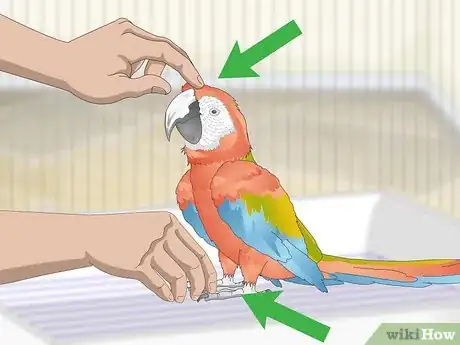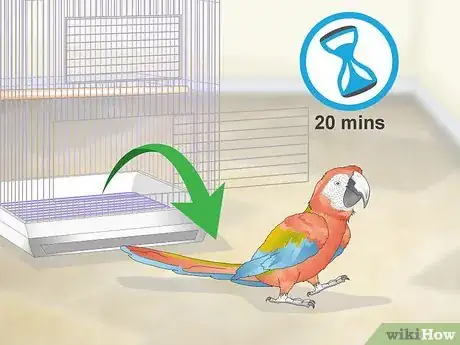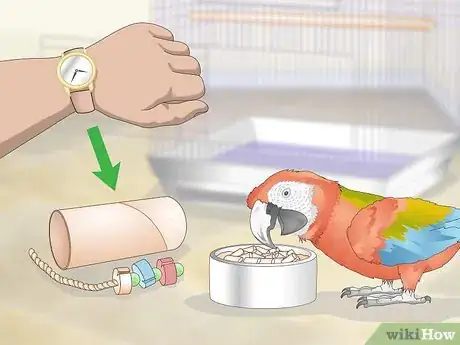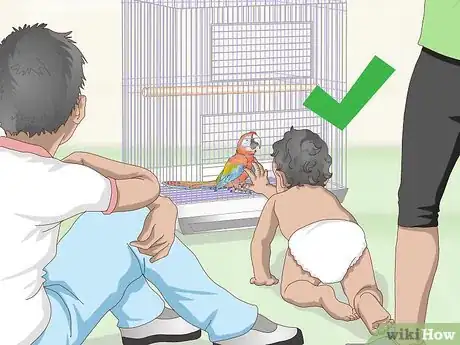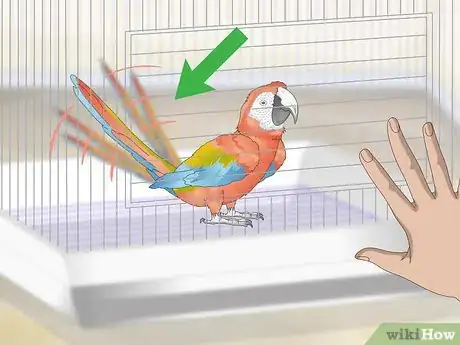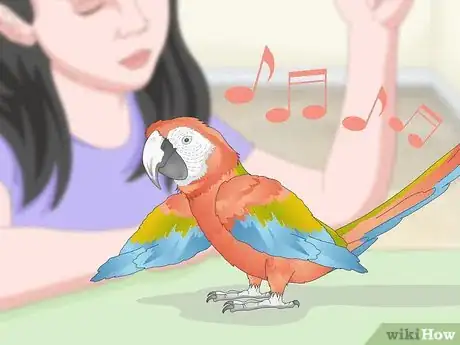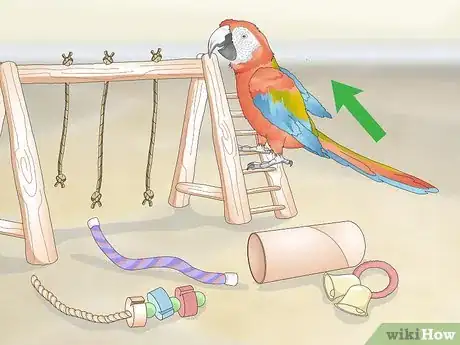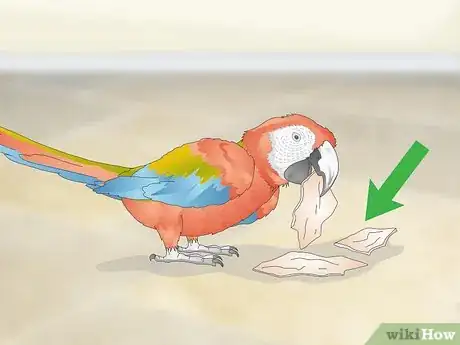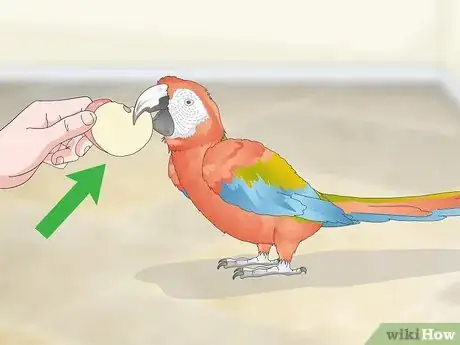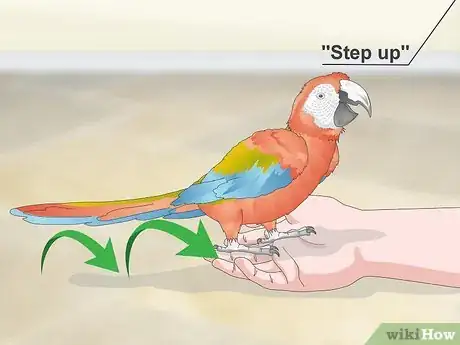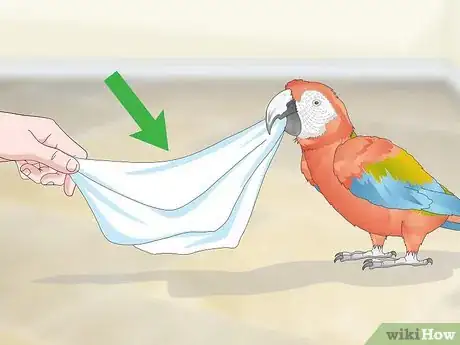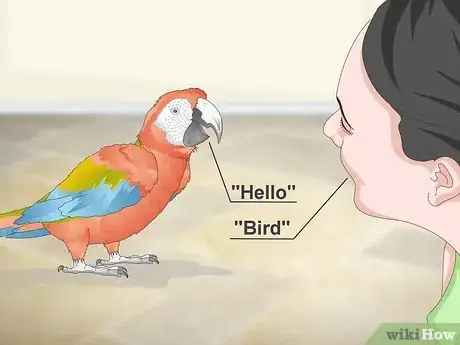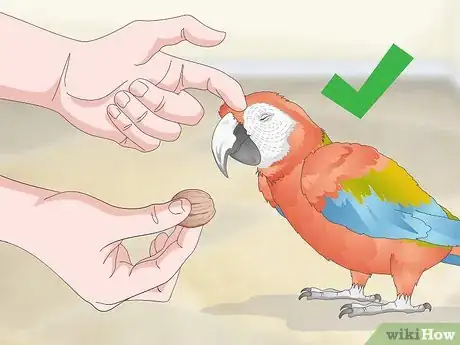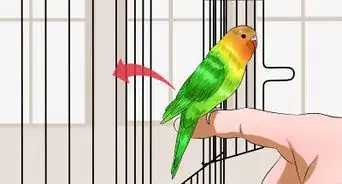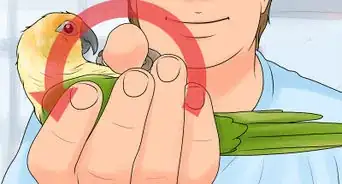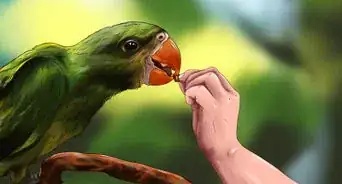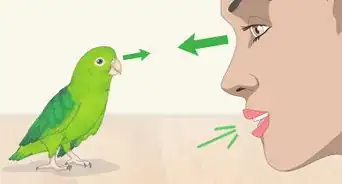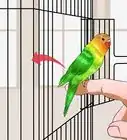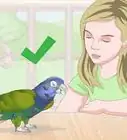This article was co-authored by Pippa Elliott, MRCVS. Dr. Elliott, BVMS, MRCVS is a veterinarian with over 30 years of experience in veterinary surgery and companion animal practice. She graduated from the University of Glasgow in 1987 with a degree in veterinary medicine and surgery. She has worked at the same animal clinic in her hometown for over 20 years.
There are 12 references cited in this article, which can be found at the bottom of the page.
This article has been viewed 27,700 times.
The bonding process starts as soon as you bring your new macaw home. Acclimating, socializing, and building a routine with your new pet can establish the foundation of a lifelong feathered friendship. Since macaws are so social, spend quality time together every day, and provide a steady rotation of toys to keep it entertained. Training will also help solidify your bond, so teach it commands and tricks, and use treats and praise to reinforce positive behaviors.
Steps
Forming an Initial Bond
-
1Learn how to correctly pet your macaw. Proper handling is a vital part of acclimating and socializing your new bird. Pet or caress its head and feet only, as it might interpret full strokes from the head to tail as mating behavior. It might become more possessive of you if it views you as a mate instead of as a companion.[1]
- It’ll appreciate head scratches, where itchy new feathers grow that it can’t quite reach.
- Touching its feet will help prepare it for nail trimmings in the future.
-
2Provide plenty of out of cage time during the first two days. If your macaw is already tame and confident, start forging your bond by spending lots of out-of-cage time with it. When you first bring it home, keep it out of its cage for at least 20 minutes, and try to keep cage time to a minimum during the day.[2]
- If you keep it in its cage when you first bring it home, it might view the cage as its only safe spot. Close off the room where the cage is located, and hang out with your bird in the secured room to help it get used to you and its new home.
- If the bird isn't tame or seems anxious, keep it in its cage until it gets used to its new home.
Advertisement -
3Establish a routine. Feed and play with your bird at approximately the same daily times, and work on getting it used to being alone for a little while. Try leaving the house, then come back inside immediately. Leave again and stay outside for longer increments to help prevent separation anxiety when you leave for a longer duration.[3]
- When you enter the house, don’t rush to the cage. Wait a few minutes before approaching the cage so the bird doesn’t expect immediate attention when you walk in the door.
-
4Have all of your household members interact with your macaw. Macaws often bond with just one owner or household member. Have everyone in your home talk, play, and offer treats to your new macaw to socialize it. It might not truly bond with others, but it’ll become used to their presence.
-
5Get to know your bird’s body language. Observing your individual bird is the best way to learn how it communicates. However, some behaviors have common meanings among parrots. For example, a lifted crest, tail shake, hopping, and hanging from the cage usually mean it wants to play.[4]
- A fully extended or flat crest accompanied by hissing is a sign of aggression. Tail bobbing (pumping with its breath) means your parrot is trying to catch its breath.
Playing with Your Pet
-
1Spend lots of quality time with your macaw. All macaw species are social and fairly dependent birds. You’ll need to spend time with it every day, and it shouldn’t go more than several hours by itself.[5]
- Talk, dance, and play with your macaw daily, and keep its cage in a place where it can see you when you’re reading, watching television, or just relaxing.
- Avoid going out of town for the first year. When you do eventually have to leave it for more than a day, have someone you and the parrot both trust housesit.
-
2Provide plenty of toys and teach your macaw how to play with them. Keep a steady rotation of toys with a variety of colors, textures, and moving parts. When you introduce a new toy, play with it yourself in front of your macaw so it understands that the new object is a fun thing.[6]
- Given their intelligence, food dispensing puzzle toys are great for macaws.
- Replace an older toy with a new one or another from its collection every week or two so it doesn’t get bored.
-
3Make sure your macaw has objects it can chew and destroy. Macaws love to chew and destroy, so give it parrot chew toys, cardboard, wood scraps, and natural branch perches (such as manzanita or eucalyptus) to help satisfy its instinct to nibble.[7]
- Providing objects it can chew will help keep it from biting or nibbling on your fingers. Nothing is worse for bonding with your macaw than a bite from its powerful beak.
Training Your Macaw
-
1Use food rewards to train your macaw. Macaws are food-driven birds, so treats will come in handy during training. Experiment with a variety of parrot treats and seeds to find its favorites. Offer treats when you’re teaching it specific commands and to reinforce acceptable behavior.[8]
- You can also try sharing your own food, as long as it's bird-friendly. For example, you could eat a banana in front of the bird and offer him a small slice. This can help it bond with and trust you.
-
2Teach your macaw the step up command. Having it step up onto your hand or arm is the safest way to handle a large bird, and most parrots can easily learn the command. Hold your arm or a handheld perch just above and in front of your parrot’s feet. Offer a treat to encourage it to get onto your arm or the perch, and say “Step up!”[9]
- Give it the treat even if it just reaches without stepping up. Repeat the process until it actually steps up, but take breaks if your bird shows signs of frustration.
-
3Towel train your bird. Teaching your macaw to love towels will make it easier to restrain it if it ever becomes necessary. Show it a hand towel and offer a treat when your bird investigates it. Play games like peekaboo and tug, and give lots of verbal praise when it’s near the towel so it forms a positive association.[10]
- If you need to restrain your bird to bring it to the vet or give it medicine, a positive association with the towel will help keep it calm.
-
4Teach your bird to talk. While they’re not considered the best talkers in the parrot family, macaws can be taught to memorize words. When teaching your macaw to talk, speak clearly, slowly, and start with easy words like “hello,” “bird,” or its name. Repeat the word over and over again, and offer treats and lots of praise when it speaks for the first time.[11]
-
5Use positive reinforcement training to deal with behavior issues. Ignore negative behaviors as best you can, and offer treats and praise to reinforce acceptable behaviors. Avoid using force or yelling to punish negative behaviors, or you might accidentally reinforce them.[12]
- For example, train your macaw to make less noise by ignoring sounds you don’t like and offering treats when it makes quieter vocalizations. Keep in mind macaws are naturally noisy, so you’ll have to accept some vocalizations.[13]
- If it bites or acts aggressively, blow gently in its face to deter its biting, but otherwise ignore it. Give it a treat when you see it playing nicely and independently with its toys.[14]
- When you ignore unwanted behaviors, don’t even look at your macaw. If possible, leave the room for a few minutes.
References
- ↑ http://bestfriends.org/resources/bird-handling-techniques
- ↑ http://www.parrotscanada.com/birdowner/forthenewbirdowner.html#The First Two Days
- ↑ https://www.beautyofbirds.com/newbird.html
- ↑ https://www.beautyofbirds.com/communicatewithyourbirds.html
- ↑ http://avalonaviary.com/large-macaws.aspx
- ↑ https://www.beautyofbirds.com/newbird.html
- ↑ http://www.exoticpetvet.com/macaw-care.html
- ↑ https://www.beautyofbirds.com/macawbehavior.html
- ↑ http://bestfriends.org/resources/bird-handling-techniques
- ↑ http://bestfriends.org/resources/bird-handling-techniques
- ↑ https://www.beautyofbirds.com/macawsaspets.html
- ↑ https://fall2016.iaabcjournal.org/human-avian-bond/
- ↑ https://www.beautyofbirds.com/noisyparrots.html
- ↑ https://www.beautyofbirds.com/breakingparrots.html
- ↑ http://www.brisbanebirdvet.com.au/Portals/brisbanebirdvet/pdf/BBV_The-Human-Bird-Bond.pdf
About This Article
When you first get your macaw, start building a bond by petting it appropriately and touching only its head and feet. If you stroke your macaw’s back, it may think you are trying to mate. While your bird is acclimating to its new home, let it out of the cage for at least 20 minutes a day if it’s calm enough. You can also help your bird feel comfortable by sticking to a daily routine and giving it time around the whole family. Finally, take time to understand your parrot’s body language. For example, hopping and tail shaking means it’s ready to play! Keep reading for more advice from our Veterinarian co-author, including how to play with your macaw.
